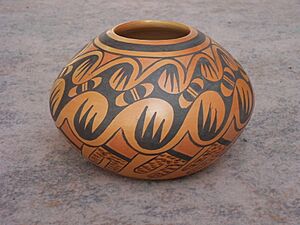Elva Nampeyo facts for kids
Quick facts for kids
Elva Nampeyo
|
|
|---|---|
| Born | 1926 First Mesa, Arizona
|
| Died | 1985 (aged 58–59) |
| Nationality | American |
| Known for | Pottery |
| Spouse(s) | Richard Tewaguna |
Elva Nampeyo (1926–1985) was an American studio potter. She was also known as Elva Tewaguna. Elva came from a famous family of potters.
About Elva Nampeyo
Elva Nampeyo was born in 1926. Her family belonged to the Hopi-Tewa Corn Clan. They lived on First Mesa, Arizona, in the Hopi lands. Her parents were Fannie Nampeyo and Vinton Polacca.
Elva's grandmother, Nampeyo, was very important. She helped bring back old ways of making pottery. This started a strong family tradition of pottery making. As a child, Elva loved watching her grandmother create pots. Later, her mother taught Elva and her brothers and sisters how to make pottery.
Family and Art
Elva married Richard Tewaguna. They had five children together. Four of their children also became potters. Their names were Neva, Elton, Miriam, and Adelle. They all continued the family tradition. When they signed their pottery, they used their first name. Then they added "Nampeyo" and a special ear of corn symbol.
Elva's Pottery Style
Elva became very skilled at decorating and painting pottery. She often used black and red colors on yellow bowls and jars. Her designs often showed traditional migration patterns. She also used eagle pictures. Her pottery usually looked a lot like the work of her mother and grandmother.
Sometimes, Elva would try new designs of her own. She really enjoyed making pottery. She could even make up to eight pots in one day! In her later years, her daughter Adelle helped her. Adelle would help polish, decorate, and fire the pottery. Elva signed her pottery as "Elva Nampeyo." She also added the corn clan symbol. Her mother, Fannie, had started using this symbol.


